If you are unsure about what to do with that bag of bulgur in your pantry, you’re not alone. It’s just not as popular as grains like brown rice or quinoa here in the U.S. But you’re in the right place.
I grew up eating (and cooking) this ancient grain on the regular, and on this site, you’ll find plenty of approachable and flavorful recipes using bulgur wheat. Start with this Turkish bulgur pilaf recipe, and when you are ready for more, learn How To Prepare and Cook Bulgur like rice or try my Chicken with Bulgur and Tabbouleh Salad recipes.

What You Need To Know in a Nutshell
- What is Bulgur Pilaf? Also referred to as bulgar pilaf, bulgur pilavi, or bulghur pilaf, this traditional dish is made by cooking bulgur with aromatic vegetables and spices. It’s a beloved staple across Mediterranean and Middle Eastern countries, especially in Turkish, Lebanese, and Armenian cuisines. Made with coarse bulgur, it has a chewy texture and a naturally nutty flavor that makes it both hearty and satisfying.
- Two versions to choose from: Depending on the region (or your own preference), bulgur wheat pilaf can be made with vegetables like onions, tomatoes, and peppers, or kept more basic with toasted vermicelli. Both are equally simple to prepare and delicious in their own way.
How To Make Bulgur Pilaf?
This Mediterranean Bulgur Wheat Pilaf recipe comes together in just a few steps with pantry staples. Here is how you cook it:
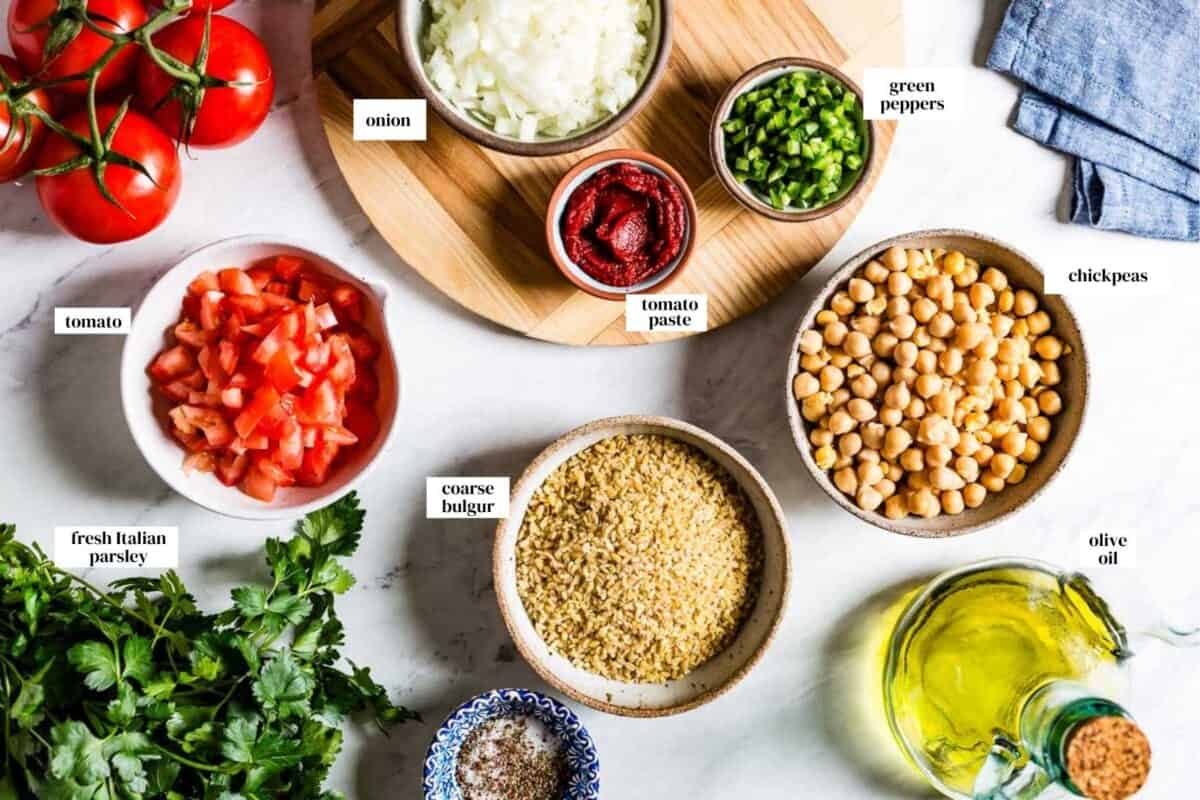
- Gather your ingredients: For the full list of ingredients, check out the recipe card below. Here are a few helpful notes and substitution ideas:
- Bulgur: You’ll find several types of bulgur at the store, but for this recipe, coarse or extra coarse bulgur works best. I usually order mine online (affiliate link), but Bob’s Red Mill red bulgur is a good alternative and easy to find in most grocery stores.
- Tomato: One large fresh tomato is all you need. If you do not have fresh tomatoes on hand, you can either omit it or add one more tablespoon of tomato paste.
- Pepper: A small green bell pepper can be used instead of jalapenos.
- Cooking liquid: For extra flavor, use vegetable stock or chicken stock instead of water.
- Spices and herbs: Ground cumin and fresh parsley are classic choices, but feel free to experiment with other spices such as ground coriander and paprika. The same applies to fresh herbs. If you have it on hand, a combination of fresh mint, dill, and parsley would be fantastic in this Mediterranean bulgur recipe.

- Saute aromatics: Heat olive oil in a medium saucepan over medium heat. Add onion, ground cumin, green pepper, and saute until translucent, 4-5 minutes. Stir in the minced garlic and tomato paste and cook, stirring constantly, for a minute or so.
- Add in the rest of the ingredients: Add in bulgur, chopped tomatoes, chickpeas, and your cooking liquid of choice. Season with salt and pepper, and stir to combine everything evenly.
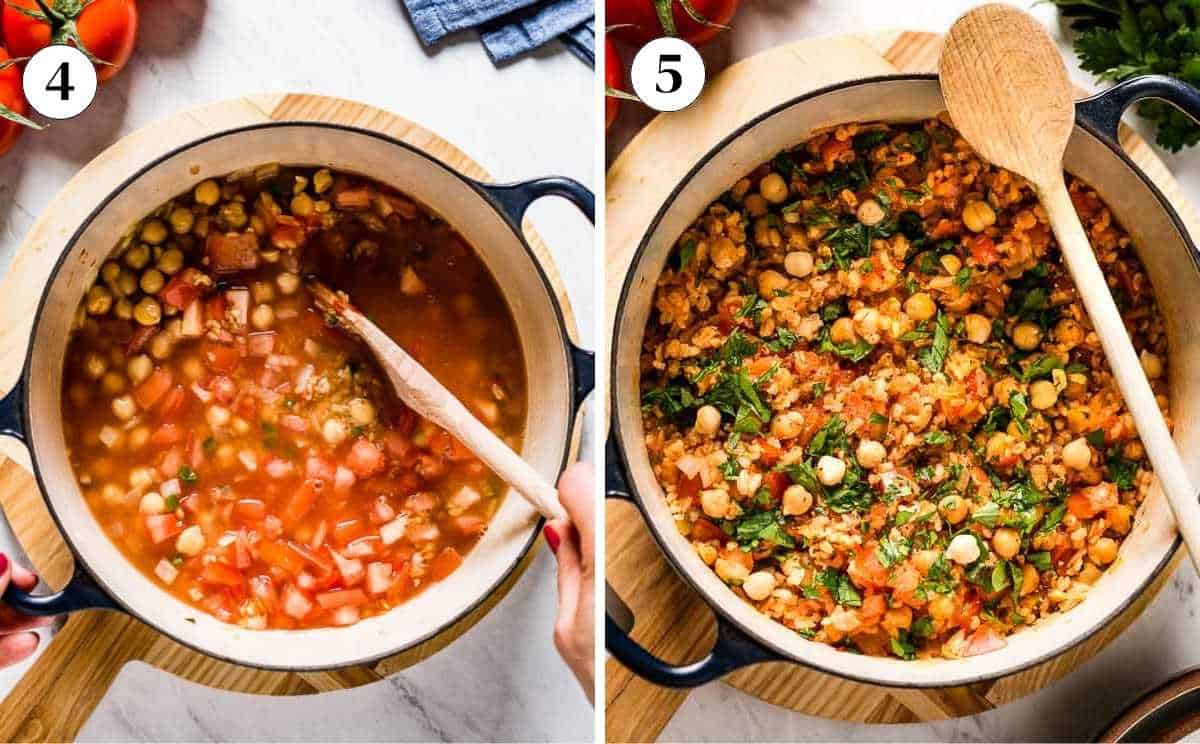
- Let it cook: Bring it to a boil, put the lid on, and lower the heat. Let it simmer for 10-12 minutes or until most of the liquid is absorbed.
- Let it rest & serve: Off the heat, rest for 10 minutes (with the lid on), fluff it with a fork. Garnish with fresh chopped parsley and serve.
Bulgur With Vermicelli – Mom’s Version
A lot of Turkish rice dishes include vermicelli, like the classic Vermicelli Rice Pilaf. So it’s no surprise that bulgur pilaf with vermicelli is also a popular variation. As a matter of fact, it was one of my mom’s signature recipes.
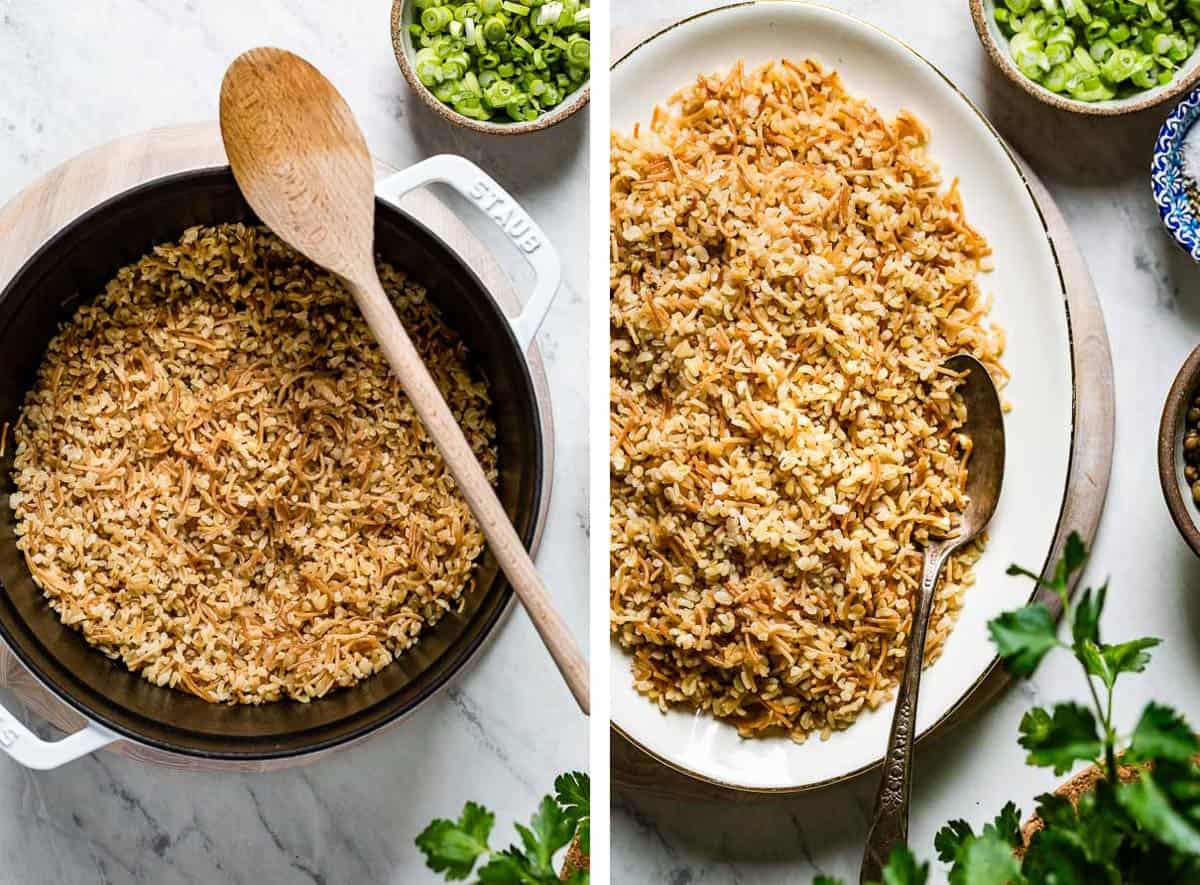
To cook Bulgur Pilaf with Vermicelli:
- Heat oil (or butter): You can use any oil, but as is usually the case, butter makes this pilaf taste better. Heat it on medium heat.
- Saute vermicelli: Add in ¼ cup of the vermicelli (or orzo) and saute until it is golden brown. It should feel like it is almost burning.
- Add in the coarse bulgur wheat: Add in bulgur wheat and saute for 4-5 minutes while constantly stirring.
- Add in the liquid & bring it to a boil: Add in your cooking liquid (water, stock, or a combination), salt, and pepper. Stir to combine.
- Cook: Bring it to a boil, put the lid on, turn down the heat, and let it simmer for 12-15 minutes.
Expert Tips
- Use the right bulgur grind: For the best texture, stick with coarse or extra coarse bulgur (sometimes sold as “pilavlik bulgur”). Finer (sold as fine bulgur) varieties tend to become mushy and won’t give you the signature chewy bite that it is known for. If you are new to cooking bulgur and adding it in your recipes, feel free to check out my post I wrote on Types of Bulgur Wheat.
- Should you rinse bulgur before cooking? It’s totally up to you. Rinsing isn’t required, especially if your bulgur is pre-packaged and clean. But if you’re buying from bulk bins, a quick rinse under cold water is a good idea.
- Toast for extra flavor: If you have a few extra minutes, toast the bulgur briefly before adding the liquid. It might come as an extra step, but doing so deepens the nutty flavor and adds a subtle complexity to the overall dish.
- Liquid-to-bulgur ratio: My go-to ratio for 1:2, meaning for every 1 cup of coarse bulgur, you will need 2 cups of liquid. That said, depending on the brand and grind of bulgur, you might need slightly more or less liquid. If the grains still feel firm after the liquid is absorbed, add a splash of hot water, cover, and let it sit a bit longer.
- Do not skip the resting: Letting the pilaf rest covered after cooking helps the grains fully absorb any remaining moisture and gives you a fluffier final dish.
- Adjust the seasoning after cooking: Taste your bulgur pilaf before serving and adjust the salt, pepper, or herbs to your liking. While it is optional, a squeeze of lemon juice just before serving can brighten the flavors beautifully.
Serving Suggestions
Traditionally, bulgur pilaf is served with chicken or beef recipes as a side dish. That being said, it can stand on its own as a vegetarian dish, especially if it is served with a side salad. Here are a few of my favorite pairings:
- Red meat: Bulgur pilaf pairs beautifully with hearty meat dishes, especially the ones with rich sauces that the pilaf can soak up. Try it with my eggplant beef stew or Ina’s pot roast to add a Mediterranean twist to your meal. And if you’re in the mood for something a little lighter, it goes perfectly with lamb meatballs.
- Chicken: This pilaf is the perfect side dish for classic Middle Eastern chicken recipes. Serve it with juicy Shawarma Chicken or Shish Taouk for a meal that feels special but is super easy to pull together.
- Vegetarian: For a simple vegetarian meal, serve the pilaf with creamy cucumber and yogurt sauce (aka tzatziki), yogurt dressing, or a cold glass of ayran. Or, if you’re feeling a bit fancy, use it as a filling in my Vegetarian Stuffed Eggplant recipe—it’s a beautiful dish that looks impressive but is easy enough for a weeknight dinner.
This Bulgur Pilaf recipe is one of the most popular Turkish recipes on Foolproof Living, and for good reason, it is absolutely delicious. If you try it, please leave a comment and rating below to let me know how it turned out. And don’t forget to tag your photos on Instagram with #foolproofeats so I can see and share your creations!

Turkish Bulgur Pilaf Recipe
Ingredients
- 2 tbsp olive oil, or butter
- 1 onion, chopped, medium sized (approximately 1 cup)
- 1 teaspoon ground cumin
- 1 green pepper, seeded jalapeno or a small bell pepper would work (approximately 1/2 cup)
- 2 cloves garlic, minced
- 2 tbsp tomato paste
- 1 cup coarse bulgur, both coarse and extra coarse bulgur would work for this recipe
- 1 fresh tomato, cut into small cubes (approximately 1 cup)
- 1 can chickpeas, 14 oz. can, drained and rinsed
- 2 cups water, or vegetable broth
- 1 teaspoon kosher salt
- 1/4 teaspoon ground black pepper
Garnishes
- 2 tablespoons fresh parsley, chopped
Instructions
- Saute onion and tomato paste: Heat olive oil in a medium saucepan over medium heat. Add in onion, cumin and green pepper and saute until translucent, 4-5 minutes.
- Stir in the minced garlic and sautee for 30 seconds. Add in tomato paste and stir constantly for a minute or so.
- Add in bulgur wheat, tomatoes, chickpeas, and water (or stock). Season it with salt and pepper.
- Stir to combine, bring it to a boil, put the lid on, and turn down the heat to low. Let it simmer for 10-12 minutes or until most of the liquid is absorbed.
- Off the heat, allow it to rest for 10 minutes (with the lid on), fluff it with a fork, garnish with parsley, and serve.
Video
Notes
- Yields: This recipe makes about 4 cups of bulgur pilaf, which serves four people as a side dish. The nutritional values below are per serving.
- Storage: Store leftovers in an airtight container in the refrigerator for up to 4 days. Reheat in a pot with a splash of water over medium heat until warmed to your liking.
- Freezing: Bring leftovers to room temperature, transfer to a freezer-safe container, and freeze for up to 2 months. Thaw it a day in advance in the fridge and warm it up on the stove before you are ready to serve it.
- Bulgur and Vermicelli Pilaf: An earlier version of this recipe included a more basic bulgur pilaf made without tomatoes, tomato paste, vegetables (onion, pepper, etc.) and chickpeas. It is how my mother made it. To cook Bulgur Pilaf with Vermicelli:
- Heat oil (or butter): Heat oil in medium heat.
- Saute vermicelli: Add in 1/4 cup vermicelli and saute until it is golden brown for 5-6 minutes while constantly stirring it with a wooden spoon. It should feel like it is almost burning.
- Add in the coarse bulgur wheat: Add in bulgur and saute for 4-5 minutes while constantly stirring.
- Add in the liquid & bring it to a boil. Add in your cooking liquid (water, stock, or a combination), salt and pepper. Give it a stir. Bring it to a boil, put the lid on, turn down the heat, and let it simmer for 12-15 minutes.
- Rest & Serve: Let it rest (with the lid on) for 10 minutes and then fluff it with a fork before serving.
Nutrition
Nutrition information is automatically calculated, so should only be used as an approximation.



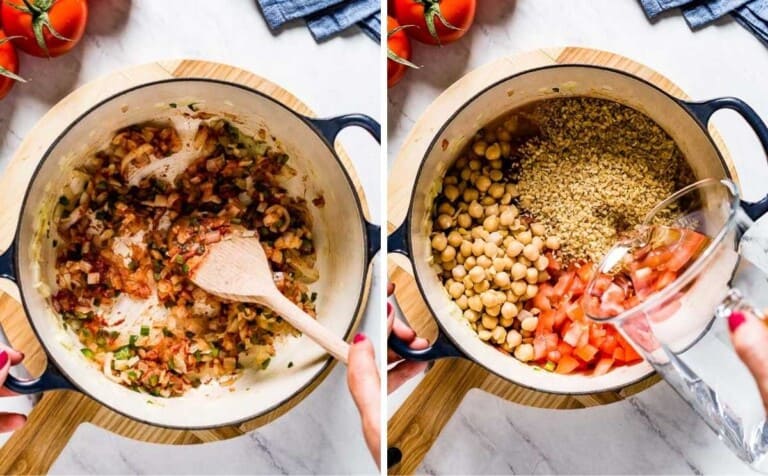
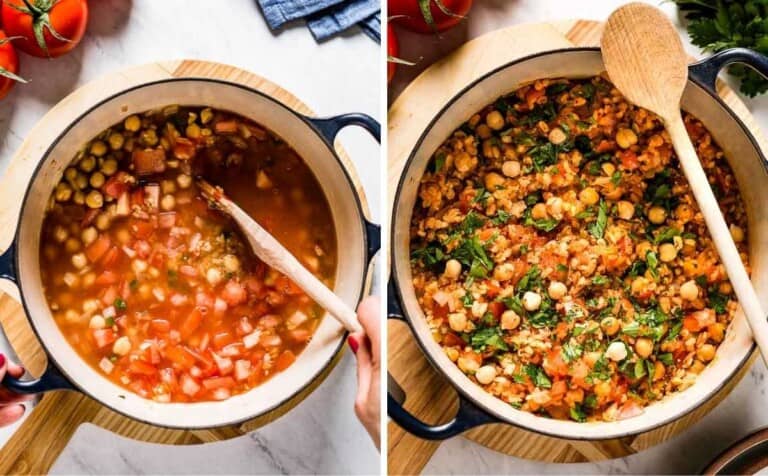
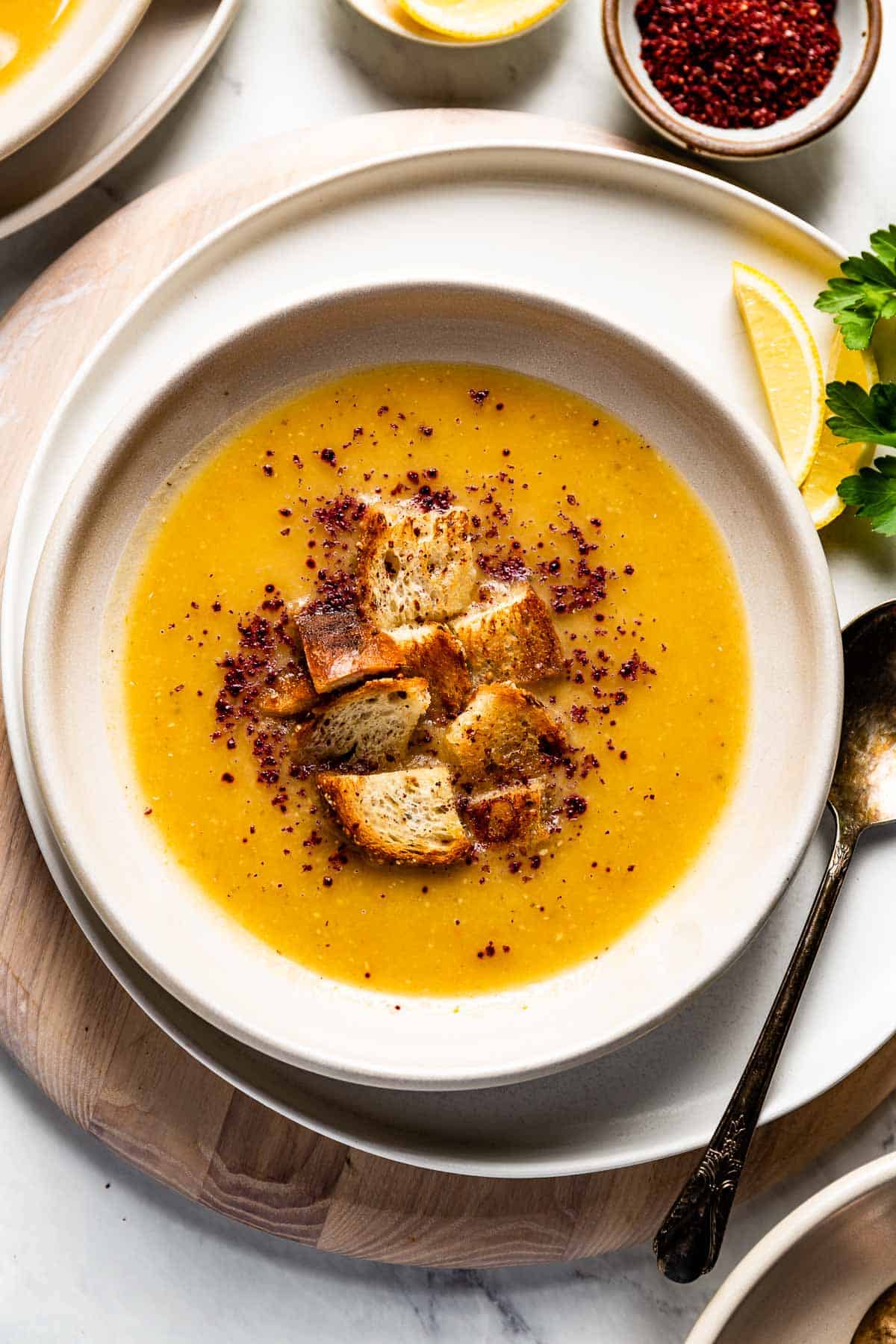
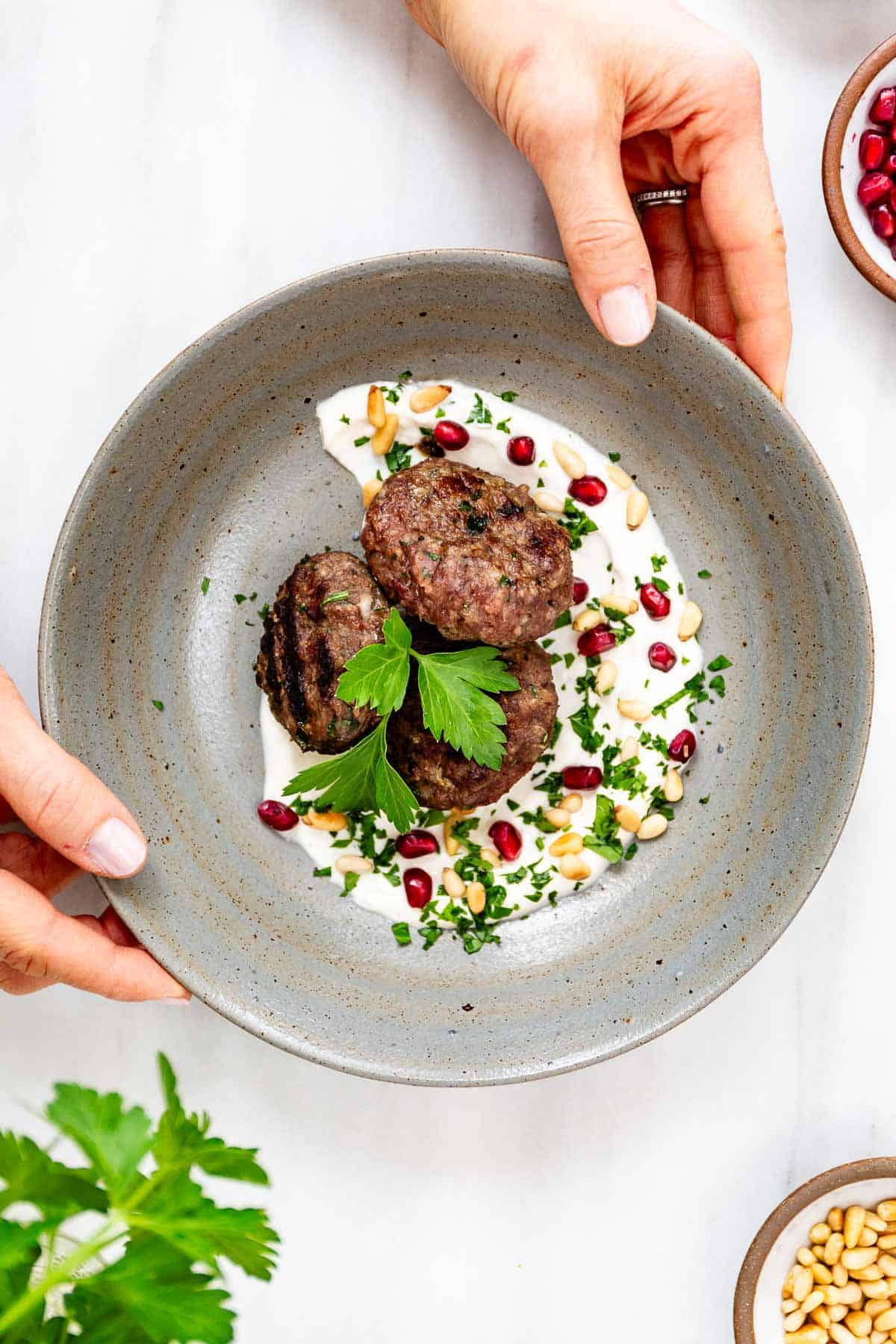











I made this recipe with 1 cup of bulgur, just like it says here.
If I make 2 cups and double all the ingredients, should I double the time for the bulgur to boil in low heat?
Thank you very much for your help.
Hello Vicky,
It might take a bit longer but I do not think that doubling the time is necessary.
Rather, I would recommend keeping an eye on the amount of water in the pot. Once it is fully absorbed it should be cooked.
Hope this helps.
I am very new to this… can you clarify that you remove the tomatoes and the tomato paste in exchange for the vermicelli? Otherwise, the recipe remains the same. Do you have a separate recipe for your mother’s version? Thank you in advance for your help.
Hello Gina,
You can keep the tomatoes (and the paste) if you want, but my mom made it without.
I added my mom’s version in the notes section for you. Please let me know if you have any other questions.
Question… cooked or uncooked bulgur added into Turkish Bulgur Pilaf? It looks so good… can’t wait to make it today.
Thanks… Ann
It is uncooked bulgur Ann.
I hope you enjoy it.
Best,
Aysegul